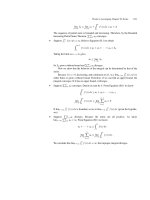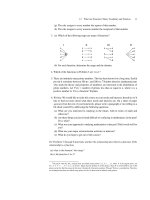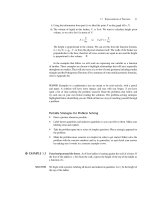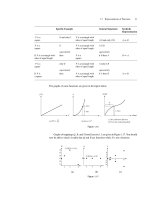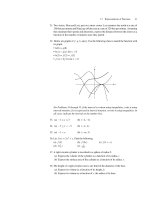Calculus: An Integrated Approach to Functions and their Rates of Change, Preliminary Edition Part 25 ppsx
Bạn đang xem bản rút gọn của tài liệu. Xem và tải ngay bản đầy đủ của tài liệu tại đây (235.31 KB, 10 trang )
6.1 A Profile of Quadratics from a Calculus Perspective 221
Notice that we have drawn families of parabolas. This is because shifting a graph vertically
does not change its slope at a given point. The derivative determines a function only up to a
constant. We have indicated by a dotted line the parabolas corresponding to those given in
Example 6.2. Although the derivative gives us information about the shape of the parabola, it
doesn’t give us any information about the vertical positioning of the parabola. The derivative
will not help us pick out any one member of the family of parabolas drawn.
◆
The Graph of a Quadratic Function
The derivative of the quadratic function f(x)=ax
2
+ bx + c is the linear function f
(x) =
2ax + b. The linear function is not horizontal because a = 0.
1
Any nonhorizontal linear
function has exactly one x-intercept; at this intercept the f
line cuts the x-axis and f
changes sign. This corresponds to a turning point of f ; the quadratic function either
changes from increasing to decreasing or vice versa.
The turning point of a parabola is called the vertex of the parabola. The derivative gives
us easy access to the shape of the parabola and the x-coordinate of its vertex; we could have
used derivatives to solve the problem in Example 6.1 efficiently, and exactly.
Question: How can we find the x-coordinate of the vertex of the parabola?
Answer:
The x-coordinate of the vertex is the zero of the derivative function, so x =
−b
2a
.
There is no need to memorize this. In practice, simply differentiate f and find the zero of f
.
Question: How can we determine whether the parabola opens upward or downward?
Answer:
If the graph of f ′ has a positive slope,
If the graph of f ′ has a negative slope,
, the parabola looks like
, the parabola looks like
If f(x)=ax
2
+ bx + c, then the slope of the graph of f
is given by “a.” Therefore
we know that
if a>0then the parabola opens upward;
if a<0then the parabola opens downward.
Definition
The slope of f
is written f
(read “f double prime”) and is called the second
derivative of f . In Leibniz’ notation f
is
d
dx
df
dx
or
d
2
f
dx
2
.
Note that
if f
> 0, then the derivative is increasing; the graph of f is concave up;
if f
< 0, then the derivative is decreasing; the graph of f is concave down.
This observation holds in general; there is nothing particular to quadratics here.
1
If a = 0 then the function is no longer quadratic; it is linear. In this case its derivative is a horizontal line, because the rate of
change of a linear function is constant.
222 CHAPTER 6 The Quadratics: A Profile of a Prominent Family of Functions
PROBLEMS FOR SECTION 6.1
1. On the left below are graphs of the quadratic functions f , g, h, and j. Match f
, g
, h
,
and j
with the lines drawn on the right.
f
x
g
x
y′
x
(i)
h
x
j
x
graph of f graph of g
graph of h graph of j
y′
x
(ii)
y′
x
(iii)
y′
x
(iv)
For each of the quadratics in Problems 2 through 4, identify the x- and y-coordinates
of the vertex and determine whether the vertex is the highest point on the curve or the
lowest point on the curve.
2. y = 2x
2
− 3x + π
3. y =−
√
3x
2
+
√
27x + 15
4. y =−
2x
2
+7
4
+
3x−1
3
For Problems 5 through 8, find a quadratic or linear function f(x)whose derivative
is the line specified and whose graph passes through:
(a) the origin,
(b) the point (0, 2).
5. (a) f
(x) = 3 (b) f
(x) = π
6. (a) f
(x) = 2x (b) f
(x) =−2x+8
7. (a) f
(x) = 6x − 2 (b) f
(x) = mx + b, m = 0
8. (a) f
(x) = πx (b) f
(x) =−
x
3
6.2 Quadratics From A Noncalculus Perspective 223
6.2 QUADRATICS FROM A NONCALCULUS PERSPECTIVE
In this section we’ll look at quadratics without using calculus. This is a different perspective
on the same material to help you get a better intuitive feel for quadratics. In addition, we
will take the opportunity to discuss the zeros of a quadratic, because the derivative gives us
no information about the roots.
The graph of a quadratic function is a parabola opening up or down; conversely, a
parabola opening up or down is the graph of a quadratic function. y = x
2
is an example
of a parabola opening upward; y =−x
2
is an example of a parabola opening downward.
x = y
2
is an example of a parabola opening to the right, and x =−y
2
is an example of
a parabola opening to the left.
y
x
y = –x
2
x = –y
2
y
x
x = y
2
y
x
y
x
y = x
2
For the most part we are interested in the graphs of functions of x; therefore, when
studying the latter two graphs, we will usually be restricting our interest to y =
√
x,
y =−
√
x, y =
√
−x, and y =−
√
−x.
y = – √–x
y
x
y
x
y
x
y = – √x
y = √–x
y
x
y = √x
A parabola has one turning point, called the vertex of the parabola.
s
vertex
s
Figure 6.4
The graph of a quadratic function is symmetric about its longitudinal axis, the vertical
line through its vertex. Verification is left as an exercise (see the Problems for Section
6.2). Look at the simplest quadratic function, f(x)=x
2
, as an illustration of this
symmetry.
We find the x-intercepts of a parabola by solving ax
2
+bx + c =0. The solutions are
given by the quadratic formula:
2
2
The quadratic formula is discussed in Reference Section A: Algebra, Part IIIB.
224 CHAPTER 6 The Quadratics: A Profile of a Prominent Family of Functions
x =
−b
2a
±
√
b
2
− 4ac
2a
.
The number of roots depends on the sign of b
2
− 4ac; there are two distinct roots if
this expression is positive, one root if it is zero, and no real roots if it is negative.
If ax
2
+ bx + c = 0 has no solutions, then the parabola y = ax
2
+ bx + c has no
x-intercepts.
If ax
2
+ bx + c = 0 has one solution, then the parabola y = ax
2
+ bx + c has one
x-intercept.
3
If ax
2
+ bx + c = 0 has two solutions, then the parabola y = ax
2
+ bx + c has two
x-intercepts.
y
x
y
x
no x-intercepts
one x-intercept
y
x
two x-intercepts
Figure 6.5
By thinking about the symmetry of the parabola we can see the following.
If there are two distinct x-intercepts, then the x-coordinate of the vertex lies midway
between them. Compute the average of the two distinct roots of the corresponding
quadratic equation by adding them and dividing by 2; you’ll get x =−b/2a. Therefore
the vertex of the parabola must have an x-coordinate of −b/2a.
Note that the number midway between Q + R and Q − R is Q;
(Q + R) +(Q − R)
2
=
2Q
2
= Q.
If there is only one x-intercept, then that intercept, x =−b/2a, is the x-coordinate of
the vertex. (Why? Think graphically.)
If there are no x-intercepts, then we use the fact that the x-coordinate of the vertex is
midway between the points of intersection of the parabola and any horizontal line y = d
that cuts it in two points. This means the x-coordinate of the vertex is midway between
the solutions to ax
2
+bx + c =d for some d, and the assertion about the vertex being
at x =−b/2a follows. (Basically, the “c” in the quadratic formula is adjusted so that
there are two roots.)
The parabola given by f(x)=ax
2
+bx + c opens upward if a>0and downward if
a<0.
Reasoning: For x large enough in magnitude (think about x →∞and x →−∞),
the ax
2
term dominates the other two terms; by this we mean that it overpowers the
3
This is a real root with multiplicity two. If r is a root of multiplicity two, then the polynomial has the factor (x − r)
2
as
opposed to simply (x −r).
6.2 Quadratics From A Noncalculus Perspective 225
other terms and determines the sign and behavior of f . x
2
is always positive, allowing
us to reason as follows.
If a>0,then ax
2
is positive. Therefore f(x)is positive for |x| large enough, and the
parabola opens upward.
If a<0,then ax
2
is negative. Therefore f(x)is negative for |x| large enough, and the
parabola opens downward.
Three points determine a quadratic. If we know three points satisfying the equation
y = ax
2
+ bx + c, we can solve a system of three simultaneous linear equations
4
for
the three unknown constants, a, b, and c.
5
If one of the points we know happens to be
the vertex of the parabola (and we are aware of that), then the parabola is determined
by just the vertex and one other point.
6
4
See Reference Section B on Simultaneous Equations.
5
We know that two points determine a line. Essentially, the number of points needed to determine a particular type of equation
boils down to the number of constants one can “play around with” in the equation’s general form. For example, for a linear equation
y = mx + b, we can adjust the m and the b; two points or independent pieces of information are needed. A quadratic equation
y = ax
2
+ bx + c has three constants that we can modify, so we need three points to determine its equation.
6
Why? Using the symmetry of the parabola over the vertical line through its vertex, from the second point we can find a third
point.
226 CHAPTER 6 The Quadratics: A Profile of a Prominent Family of Functions
Exploratory Problems for Chapter 6
Tossing Around Quadratics
1. Each graph below is the graph of a function of the form f(x)=
ax
2
+ bx + c. Determinethe sign of a, b, and c: positive, negative,
or zero. Explain your criteria.
y
x
(a)
y
x
(d)
y
x
(b)
y
x
(e)
y
x
(c)
y
x
(f)
After having completed this problem, compare your strategy with
those of your classmates. There are quite a few different ways to
approach this problem.
2. Quadratics arise naturally in analyzing projectile motion due to
the physics of falling objects. In this problem you will work on
understanding why. Suppose an object is thrown straight upward
from a height of 2 feet with an initial velocity of 25 feet per
second.
(a) When an object is in free fall, the only force acting upon it is
the force of gravity. Gravity causes a downward acceleration
of 32 feet per second squared.
7
You know that acceleration is
the rate of change of velocity. Let v(t) be the velocity of the
falling object at time t, where t is measured in seconds and t =
0 corresponds to the time at which the object is thrown. The
object is accelerating downward due to the force of gravity, so
dv
dt
=−32.
7
Acceleration is
change in velocity
change in time
so we can measure it in
feet/second
second
or ft/sec
2
.
Exploratory Problems for Chapter 6 227
Find all possible functions v(t) such that
dv
dt
=−32. You will
get a family of functions. In other words, you are asked to find
the family of functions with a constant slope of −32.
(b) Pick out the one function in the family of functions found in
part (a) that is relevant to our situation by using the fact that at
time t = 0 the velocity of the object was 25 feet per second.
(c) You should now have a velocity function for the object. Let
s(t) be the height of the object at time t. You know that
velocity is the rate of change of position, and, because the
object was thrown straight up, you can equate position with
height. Therefore you can equate v(t) with
ds
dt
. At this point,
you should have
dv
dt
set equal to a linear function determined
in part (b). The work you’ve done in this chapter indicates that
s(t) could be a quadratic function. In fact, you should be able
to find a family of quadratic functions whose derivative is this
specified linear function. Use the fact that s(0) = 2 to pick
out the quadratic that gives the object’s height as a function of
time.
228 CHAPTER 6 The Quadratics: A Profile of a Prominent Family of Functions
PROBLEMS FOR SECTION 6.2
1. Let f(x)=x+3, g(x) = x − 5, h(x) = f (x)g(x), and j(x)=
f(x)
g(x)
.
Solve the following equations. Find all x that satisfy the equation.
(a) h(x) = 0
(b) h(x) =−7
(c) h(x) =−15
(d) h(x) = ccis a constant that will appear in your answer.
(e) j(x
2
)− 2=0
(f) [j(x)]
2
−1=0
(g) h(x) = j(x)
2. Match each equation below with a possible graph. a, b, and c are all positive constants.
a) y = a(x − b)
2
b) y =−a(x + b)
2
c) y = (x + b)(x + c)
d) y = (x + b)(x − c)(x + a) e) y = ax − b
2
y
x
(i)
y
x
(ii)
y
x
(iii)
y
x
(iv)
y
x
(v)
y
x
(vi)
y
x
(vii)
y
x
(viii)
3. Solve for x. Work as efficiently as possible.
(a) x
2
− 7 = 0 (b) 5x
2
= 125 (c) (x + 1)
2
= 25
(d) x
2
+ 2x + 1 = 25 (e) (2x + 3)
2
= 9(f)(3x+1)
2
=7
(g) (x + 3)(x − 1) = 0 (h) (x + 3)(x − 1) = 7
4. Sketch the graphs of the following functions. Use what you know about the basic shapes
plus shifting, flipping, and stretching to draw the graph without plotting lots of points.
In each case tell us what “basic” function you are transforming.
Label the x- and y-intercepts of each graph. Work as efficiently as possible.
(a) f(x)=2(x − 3)
2
− 5 (b) g(x) =−4(x + 1)
2
+ 3
(c) h(x) =|x+1|−3 (d) j(x)=|x−3|
(e) k(x) = x
2
− 3(f)l(x) =|x
2
−3|(Hint: This has two sharp corners.)
6.2 Quadratics From A Noncalculus Perspective 229
5. Refer to Problem 4 for your answers to this question.
(a) How many solutions are there to 2(x − 3)
2
− 5 =−6?
(b) How many solutions are there to −4(x + 1)
2
+ 3 =−6?
(c) How many solutions are there to |x + 1|−3=−2?
(d) Solve x
2
− 3 ≥ 1.
(e) How many solutions are there to |x
2
− 3|=1?
6. This question refers to Problem 4. True or false. (If the statement is false, give all
counterexamples.)
(a) All the functions in Problem 4 are continuous everywhere.
(b) All the functions in Problem 4 have derivatives that are continuous everywhere.
7. Consider the first three functions from Problem 4. At what x-values does each function
take on its maximum and minimum values on the interval [0, 4] for the parabola in part
(a)? In part (b)? In part (c)?
(This problem is equivalent to saying “Look at your graph only on the domain
[0, 4]. Where does the function take on its biggest value? Its smallest value?”)
8. Using functional notation, state the criterion for the function g to be symmetric about
the vertical line x = k. The figure below should help you arrive at this criterion.
g
K–w
K+w
w
w
x
x = K
9. We have stated that the graph of a parabola is symmetric about the vertical line through
its vertex. The goal of this problem is to prove this assertion. Since the vertex of the
parabola f(x)=ax
2
+ bx + c is at x =
−b
2a
, we must show that the graph of f(x)is
symmetric about the vertical line x =−
b
2a
. This is equivalent to showing that
f
−b
2a
+ x
= f
−b
2a
− x
for all x. (To arrive at this criterion on your own, do Problem 8.)
230 CHAPTER 6 The Quadratics: A Profile of a Prominent Family of Functions
f
x
–x
+x
–b
2a
–b
2a
–b
2a
Show that if f(x)=ax
2
+bx + c, then f
−b
2a
+ x
= f
−b
2a
− x
.
10. Find possible equations to fit the following graphs.
y
x
–2
– 4
2
y
x
–22
(1, –2)
2
y
x
–13
11. Solve for the indicated variable. (Your answers will be messy and will involve lots
of letters. Don’t let that faze you. In each problem, begin by determining whether the
equation is linear or quadratic in the indicated variable. Then solve using the appropriate
technique.)
a) Q =b(j + 3) − jQ (j) b) λ(1 + 5λ) = 3π (λ)
c)
6
=
1
3
(λ + + 1) −
1
3
λ
2
()d)=3(λ + + 1) − 2λ
2
(λ)
e) R +
R
= R + V () f) x(x +y) −yz −1 =−ky (x)
g) x =
−y±
√
y
2
−4(ky−yz+1)
2
(x)
12. Solve:
(a) x
4
+ x
2
= 6. (b) x
4
− 5x
2
=−6.
13. Solve: 2x
6
+ 5x
3
− 3 = 0.
14. Solve: (x − 2)
4
− 2(x − 2)
2
=−1.
